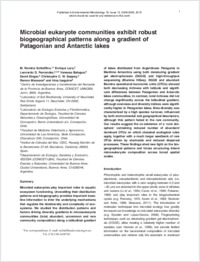Microbial eukaryote communities exhibit robust biogeographical patterns along a gradient of Patagonian and Antarctic lakes.
- Schiaffino MR Centro de Investigaciones y transferencia del Noroeste de la Provincia de Buenos Aires, CONICET, UNNOBA, Junín, 6000, Argentina.
- Lara E Laboratory of Soil Biodiversity, University of Neuchâtel, Rue Emile Argand 11, Neuchâtel, CH-2000, Switzerland.
- Fernández LD Laboratory of Soil Biodiversity, University of Neuchâtel, Rue Emile Argand 11, Neuchâtel, CH-2000, Switzerland.
- Balagué V Institut de Ciències del Mar, CSIC, Passeig Marítim de la Barceloneta 37-49, Barcelona, Catalonia, 08003, Spain.
- Singer D Laboratory of Soil Biodiversity, University of Neuchâtel, Rue Emile Argand 11, Neuchâtel, CH-2000, Switzerland.
- Seppey CC Laboratory of Soil Biodiversity, University of Neuchâtel, Rue Emile Argand 11, Neuchâtel, CH-2000, Switzerland.
- Massana R Institut de Ciències del Mar, CSIC, Passeig Marítim de la Barceloneta 37-49, Barcelona, Catalonia, 08003, Spain.
- Izaguirre I Departamento de Ecología, Genética y Evolución, IEGEBA (CONICET-UBA), Facultad de Ciencias Exactas y Naturales, Universidad de Buenos Aires. Ciudad Universitaria, Buenos Aires, C1428EHA, Argentina.
- 2016-10-07
Published in:
- Environmental microbiology. - 2016
English
Microbial eukaryotes play important roles in aquatic ecosystem functioning. Unravelling their distribution patterns and biogeography provides important baseline information to infer the underlying mechanisms that regulate the biodiversity and complexity of ecosystems. We studied the distribution patterns and factors driving diversity gradients in microeukaryote communities (total, abundant, uncommon and rare community composition) along a latitudinal gradient of lakes distributed from Argentinean Patagonia to Maritime Antarctica using both denaturing gradient gel electrophoresis (DGGE) and high-throughput sequencing (Illumina HiSeq). DGGE and abundant Illumina operational taxonomic units (OTUs) showed both decreasing richness with latitude and significant differences between Patagonian and Antarctic lakes communities. In contrast, total richness did not change significantly across the latitudinal gradient, although evenness and diversity indices were significantly higher in Patagonian lakes. Beta-diversity was characterized by a high species turnover, influenced by both environmental and geographical descriptors, although this pattern faded in the rare community. Our results suggest the co-existence of a 'core biosphere' containing reduced number of abundant/dominant OTUs on which classical ecological rules apply, together with a much larger seedbank of rare OTUs driven by stochastic and reduced dispersal processes. These findings shed new light on the biogeographical patterns and forces structuring inland microeukaryote composition across broad spatial scales.
- Language
-
- English
- Open access status
- green
- Identifiers
-
- DOI 10.1111/1462-2920.13566
- PMID 27709755
- Persistent URL
- https://sonar.rero.ch/global/documents/236906
Statistics
Document views: 19
File downloads:
- fulltext.pdf: 0
